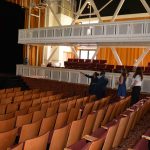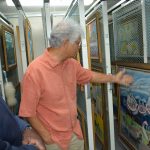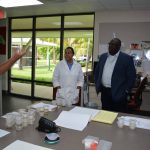Minister tours CNCF & MRCU
 Cayman Islands Minister Seymour Tours CNCF and MRCU
Cayman Islands Minister Seymour Tours CNCF and MRCU
• Minister for Health, Environment, Culture and Housing Dwayne Seymour got a close-up look at the Cayman National Cultural Foundation collection of works by local Visionary artist Miss Lassie during a recent tour.
• Later the same day the Minister visited the Mosquito Research and Control unit where he got to examine “the biggest mosquito in the Cayman Islands” under a microscope.
GRAND CAYMAN (GIS) – Minister for Health, Environment, Culture and Housing, Hon. Dwayne Seymour, began the month of June visiting departments with very different remits within his Ministry.
Despite a day-long downpour the Minister and a small team of officials, that included Chief Officer Jennifer Ahearn, Deputy Chief Officer Nancy Barnard and Policy Advisor Natasha Powell, began the day at the F. J. Harquail Cultural Centre, which is the home of the Cayman National Cultural Foundation (CNCF). Then later that same afternoon the group toured key areas of operations at the Mosquito Research and Control Unit (MRCU) Headquarters.
At the CNCF, Managing Director Marcia Muttoo and Artistic Director Henry Muttoo guided the Minister and his staff around the premises. Longtime Chairman of the CNCF Board Martyn Bould and CNCF staffers responsible for programme coordination and public education accompanied the group for much of the time.
While touring areas of interest within the theatre, such as the sound and lighting booth and stage area, the Minister learned more about the full extent of CNCF operations.
Discussion between the Ministry and CNCF teams covered the array of events held at the venue, as well as current and future revenue generation measures, including rental of the venue for community events. It also extended to the usefulness of increased community partnerships with public and private sector organisations in the tourism industry.
Other topics on the table included resource needs as well as the potential for expansion of the more-than-30-year-old theatre which currently has a seating capacity of 300.
Mr Seymour expressed particular interest in the climate-controlled storeroom where CNCF keeps its collection of works by the late Visionary artist, Gladwyn Bush, otherwise known as Miss Lassie.
Reassured that its location was secure from natural disasters, CNCF and Ministry officials discussed how the work of this exceptional artist is helping to preserve the Cayman Islands’ vanishing cultural heritage.
Mr Muttoo also shared that CNCF is editing a new coffee table book about the artist’s life and work, which they will launch publicly later this year, when the complete collection will again be exhibited.
Noting the emphasis that the national culture and heritage policy places on honouring the past, Minister Seymour said he was moved by the experience of seeing so many works by one of the Island’s most important artists, and looked forward to seeing them displayed to the public at the book launch.
The tour ended in the smaller Studio Theatre area, where the group watched a reel of cultural highlights from the CNCF year that the Foundation had commissioned from a young videographer. Mrs Muttoo also presented the Minister with a gift basket which included copies of the CNCF arts and culture journal, “Foundation”.
After spending the late morning immersed in the arts, in the afternoon the Ministry visited the home of an agency that focuses very much on the sciences.
At the MRCU Headquarters off North Sound Road, Director Jim McNelly, PhD, began by showing Mr Seymour the lab where every day two individuals count, identify and record the mosquitoes harvested by the unit’s New Jersey Light traps, at 25 designated points around the Cayman Islands.
The Minister also learned that one employee in the lab, Zoila Ebanks, has a long term association with MRCU of nearly 35 years. Whitney Ebanks is a volunteer, and is Zoila’s daughter.
A highlight of the tour came when the two women invited ministry officials to examine under a microscope what they described as the largest mosquito in the Cayman Islands. They said Psorophora ciliata, sometimes referred to as a “gallinipper”, is prone to biting mammals – cows, horses and humans.
From the main building the group crossed the grounds to the operations centre from which MRCU deploys the insecticide and larvicide that it uses to control Grand Cayman’s mosquito population.
Here the Minister asked questions about the different kinds of equipment that the team employs in different environments.
He also told a group of almost two dozen Disease Prevention Officers and other personnel that had gathered to welcome him that he was very impressed by what he had learned about their work on the visit thus far. Mr Seymour noted that the Department undertakes a much wider range of operations than most people know, and promised to do more to raise awareness of their contributions.
Next, Dr McNelly escorted the Ministry team to the trailer on the MRCU compound where biotechnology company Oxitec breeds mosquitoes that are genetically modified to reduce the local population of Aedes aegypti mosquitoes.
Oxitec and MRCU are currently partners in a programme to assess the effectiveness of the genetically modified mosquitoes in the Cayman Islands setting, in particular when deployed alongside other more traditional methods of mosquito control.
Inside the insectary, which is kept humid and warm, to promote mosquito development, the Minister chatted with some of the five young Caymanians with academic backgrounds in the sciences that Oxitec employs to assist with the project. The young people continued to carry on their efforts, sorting male and female pupae based upon size, in front of the visitors and answered questions about the process.
At the end of his visit Minister promised that he would soon tour the MRCU hangar where the plane and equipment are kept that the department uses in its aerial spraying operations.








